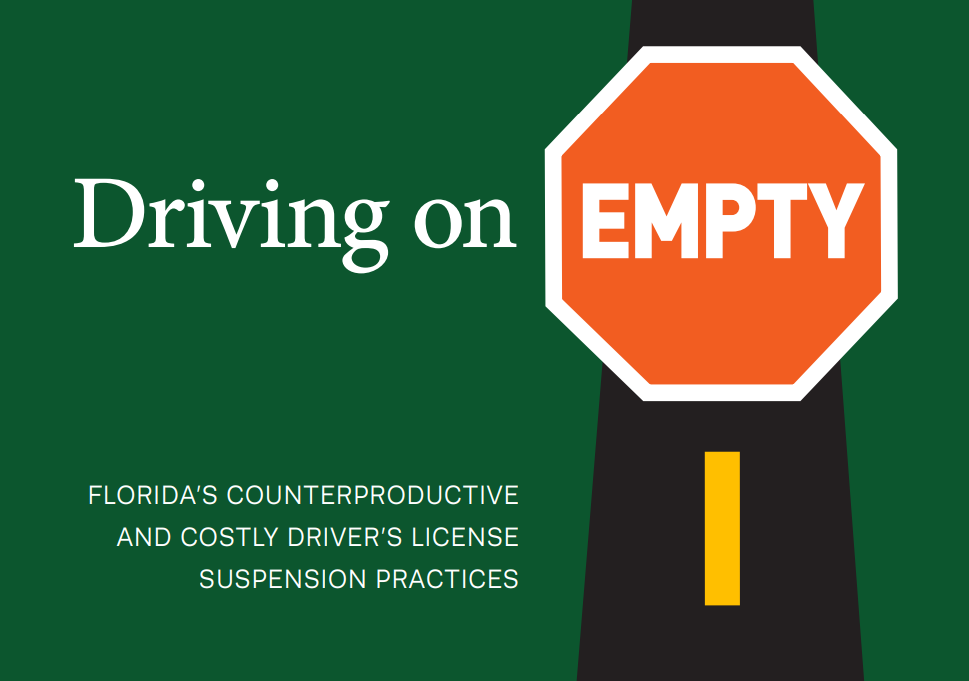As of November 2019, almost 2 million Floridians could not legally drive because of a suspended license.
Driving on Empty shows how driver’s license suspension for nonpayment detracts from public safety, and outlines the racial and economic disparities perpetuated by this practice.
You can read the full text of the report here, the executive summary here, and case studies here.
EXECUTIVE SUMMARY
Today, almost 2 million Floridians cannot legally drive because of a suspended license. That’s because Florida punishes people by suspending their driver’s license when they cannot afford to pay the steep fines and fees Florida law mandates for traffic tickets, toll violations and criminal convictions. Without a driver’s license, people can no longer be self-sufficient – they can’t reliably get to work, take their children to school, keep a medical appointment, or attend church. Losing a driver’s license can trigger years of financial hardship and a cycle of poverty and punishment few can escape.
In 2017, 1.1 million suspension notices were sent to Florida drivers because of overdue court debt. That’s one out of every fifteen drivers — in just one year. Between 2015-2017, more than 3.5 million suspension notices were issued for unpaid court debt.
Florida routinely suspends driver’s licenses when payments for traffic, toll violations and criminal fines and fees are late, with no assessment of a person’s ability to pay. Few courts offer reasonable payment plans – despite state law that requires it. And after 90 days, court debt is sent to private collections agencies that can add up to 40% of the total amount due.
Driver’s license suspensions are counterproductive and ineffective. The goal of Florida’s suspension policies is to force people to pay their fines and fees, but it doesn’t work. Driver license suspensions often last years. In the counties we analyzed, on average, 77.12% of suspensions issued from 2016-2018 remain in effect today.
License suspensions are a financial issue for most Floridians, not an indication that people are unwilling to pay their debts. Indeed, evidence demonstrates that when people are given options to pay that are within their means, they pay. In 2014, Palm Beach County implemented a program that allows for flexible payment plans. As a result, they have seen the number of payments increase by 11%; their collection rate increase from under 60% to 80%; and their referrals to collections agencies decreased by 36%.
In Florida, a driver’s license is a necessity. Almost 90% of Floridians drive to work, and large parts of the state lack reliable public transportation. When people lose their license, they often lose their job; if they find a new job, it’s often at reduced pay or for fewer hours. Once their license is suspended, people are often forced to choose between driving illegally in order to provide for themselves and their families or complying with the law and losing the ability to pay the court debt that triggered their suspensions in the first place.
The legal consequences of driving on a suspended license are severe and escalate over time. People become trapped in the justice system. They may even end up in jail or prison – all because of Florida’s futile license-for-payment scheme.
Florida’s suspension practices impact us all. Instead of targeting dangerous drivers or addressing serious crime, Florida spends its public safety resources stopping, prosecuting, and incarcerating drivers simply because they are poor. Business suffers when workers can’t reliably get to their jobs or are forced to quit because they can’t do their job without a license. Communities that most need financial investment are instead drained of economic vitality. Our research demonstrates that poor people and people of color are more likely to be affected by Florida’s suspension policies.
These disproportionate effects matter because the harms of driver’s license suspensions may exacerbate existing inequalities. For every person who has a suspended license or goes to jail for driving on a suspended license, there is a child, parent, or spouse who is also impacted.
Key Findings
- Driver’s license suspensions for nonpayment affect over a million people each year. Total suspension notices for failure to pay in 2017 represented 7.33% of the driving population in the state.
- It takes years for most people to regain their license once suspended – 75% of driver’s licenses suspended in 2016 remained suspended two years later. Plainly, suspensions are not an effective tool for coercing payment of fines and fees.
- Suspension rates are highest in areas with larger proportions of people of color and low-income people. Black people have suspended driver’s licenses on average 1.5 times the rate they are represented in the general population.
- 72% of driver’s license suspensions in Florida are for unpaid fines and fees, not for unsafe driving.
- In 2017, law enforcement issued over 232,000 citations for driving while license suspended – over 5 times the number of citations issued for Driving Under the Influence (DUI). Law enforcement, prosecutors and courts are diverting resources from serious crime and spending millions of dollars to “crack down” on people whose only crime is poverty.
